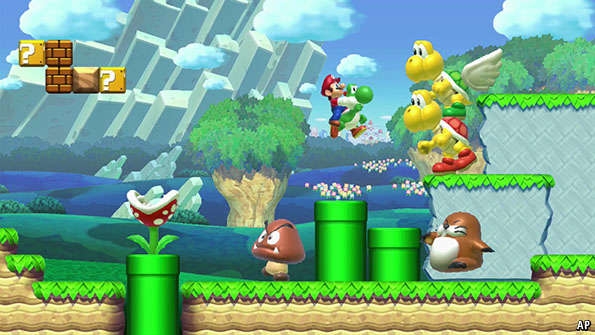
http://www.economist.com/blogs/prospero/2015/09/video-games
IF BEETHOVEN's Fifth begins, as has been said, with the sound of Fate knocking, the opening notes of the “Super Mario Bros” theme—“Da-da-dum da-dum-DUM!”—are surely the sound of fun knocking. The staccato ditty was composed to withstand repetitive replays; but, back in 1985, no one would have guessed it would need to hold up for so long.
This weekend is the 30th anniversary of the release of the Nintendo’s “Super Mario Bros,” the video game that ushered in the era of play-at-home games. Nintendo is observing the milestone with the release of a new title, the nostalgia-infused “Super Mario Maker”. The essence of the game is allowing players to design, share and play their own levels that look—if not exactly feel—straight out of past “Super Mario” titles.
Sampling selected highlights of these levels, thoughts of inmates running asylums spring to mind: the most popular resemble elaborate Rube Goldberg machines that whisk Mario to the finishing line without so much as the need to raise a pixelated finger. If anything, though, the chaos of “Super Mario Maker” serves to highlight the elegant, streamlined simplicity of the original.
The side-scrolling platformer was a burgeoning genre in 1985, set in motion by Mario’s own jump-based exploits in "Donkey Kong". “Super Mario Bros,” though, was a quantum leap forward. In fact, so much of what was revolutionary about “Super Mario Bros” can be gleaned in its earliest moments.
Shigeru Miyamoto, Mario’s creator and Nintendo’s auteur-mascot, came to video games with a background in industrial design, and there’s something of the industrial designer’s logic contained in the first moments of “Super Mario Bros” gameplay. When Mario head-butts a block that releases a gliding mushroom, the deflecting pipe and floating blocks are positioned in such a way that it’s tricky for Mario to avoid the mushroom, thereby revealing to players its power. It was Miyamoto’s way of “teaching” players that element of the game.
Nintendo was thinking about user experience more deeply than other game developers at the time. For example Mr Miyamoto had decided that the most successful games made the player get mad at himself—not the game. The level of difficulty in “Super Mario Bros” is perfectly calibrated, so subtly notching up that the player always feels that they can, of course, beat the obstacle that just defeated them the next time they play—or perhaps the time after that. Every time Mario dies and is catapulted downstage, we linger on the scene just long enough to reflect how easily we might have dodged that fireball or ricocheting turtle shell.
But of course none of this would matter if the package weren’t also enjoyable to play and, right from the outset, “Super Mario Bros” looked joyful. In 1985, the conventional wisdom was that players’ eyes would tire of anything other than a black background; it was no coincidence that there was a preponderance of space shooters around this time. Having Mario navigate a land under periwinkle blue skies, and more generally giving Mario levels that resembled real and distinct landscapes to explore—he ventures through land, sea and air—elevated “Super Mario Bros” from mere button-bashing tournament to serial adventure, with its fleet-footed plumber in the role of intrepid hero.
The game unfolded like a narrative too: in a connective cut scene between Levels 1-1 and 1-2, Mario sallies forth out of the castle and plunges straight into a pipe—with all his smiling, unchanging nonchalance—only to re-emerge in some subterranean basement world. It’s a flourish of storytelling that had nothing to do with the player’s score but everything to do with his experience of the game.
Over an unprecedentedly vast 32 levels, littered with secrets and surprises, “Super Mario Bros” would anticipate the epic exploration and discovery of Mr Miyamoto’s other beloved creation, “The Legend of Zelda” without the paralyzing sense of profound responsibility. To this day, “Super Mario” games maintain an air of breezy lightness even at their most fiendishly, thumb-callusingly complex.
Then there’s that effervescent soundtrack, developed in sync with the game itself—a unique concept at the time—by Koji Kondo. Beyond the ubiquitous opening notes of the main theme, its staccato melody has a bouncing verticality that reflects Mario’s own journey across the screen. Even the game’s sound effects, also by Kondo and emanating from all “Super Mario” games since, is intelligently infused with this brightness of mood: the two high notes that sound when a coin is collected, a semi-quaver and dotted minim combo, form a distinctly ear-pleasing perfect fourth. (It’s easier to appreciate the sophistication of Kondo’s work when you listen to other game soundtracks at the time. The soundtrack to Namco’s “Pac-Land”, a 1984 platformer precursor to “Super Mario Bros,” isn’t so much music as an ear-grating sonic assault.)
Considering the level of artistry lavished on the game, it seems incredible that the sprightly sprite at the center of it all was something of a fluke. When Mario debuted in “Donkey Kong” in 1981, his entire look—moustache, hat, overalls, the lot—was dictated by the limitations of his allotted 16x16 pixels.
And yet, that initial simplicity has been key to Mario’s immense staying power. Miyamoto, inspired by the way familiar characters would recur across the work of manga artist and Astro Boy creator Osama Tezuka, had hoped to create a character who might pop up in all sorts and styles of video games. Mario’s unassuming appearance ensured his endless malleability and cemented his place in video game history.
What that unassuming carpenter-turned-plumber needed, of course, was a moment to shine, and “Super Mario Bros” was certainly that. When gamers tire of the wacky, over-the-top offerings of “Super Mario Maker”—or, indeed, the excesses of modern gaming in general—the simple, abundant joy of Mario’s first adventure awaits. “Da-da-dum da-dum-DUM!”








